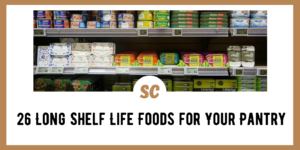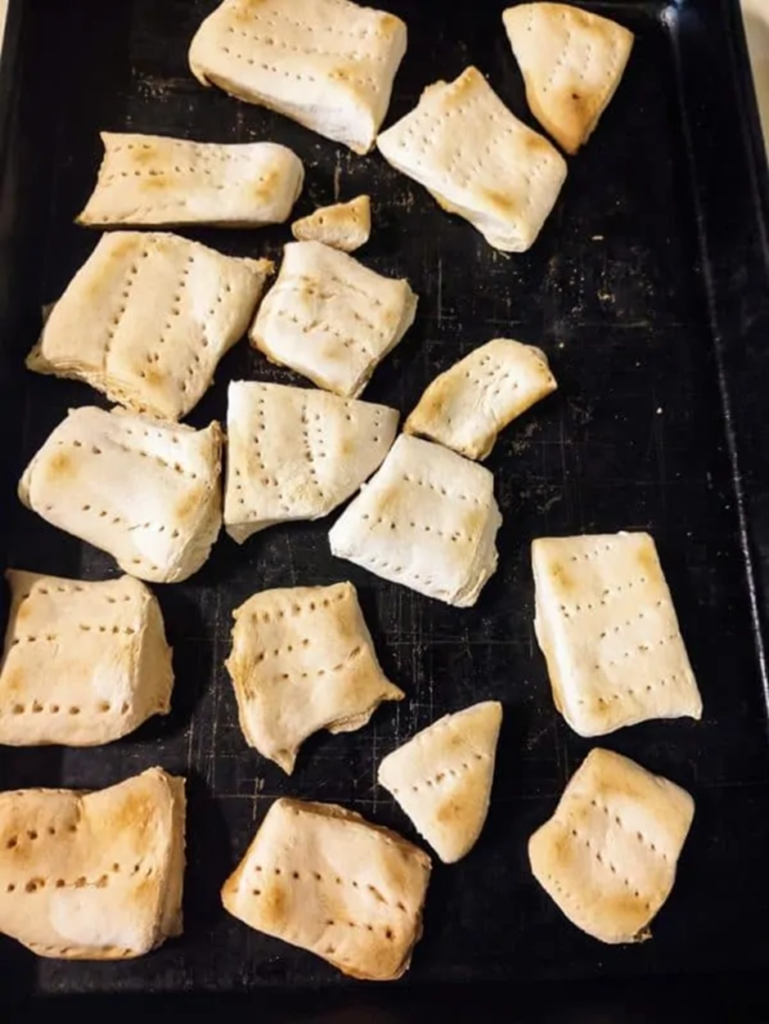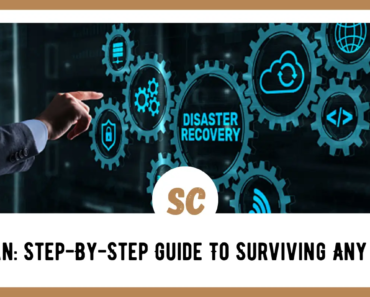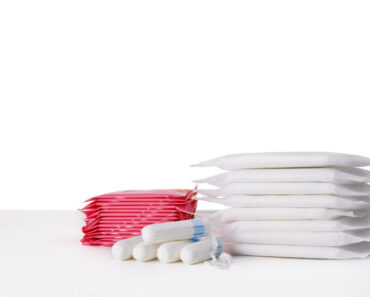In modern times, convenience tends to be king. And in many places, there is an abundance of food options on almost every street corner.
Because of these instant food options – as well as a society that has adopted a throwaway mentality – it’s easy to overlook about food items that have a long shelf life.

However, we should not forget about because many are nutritious, versatile, and even considered some of the best survival foods to have.
For many people, convenience and foods with short shelf lives are going to go right out the window when an emergency like bad weather, natural disasters, supply chain issues, shortages, and economic hardships happen. And they do happen.
That’s why, in this article, we’ll be breaking down:
- Foods with the best shelf life
- Storage requirements
- Long-lasting options like canning
26 Types of Shelf Stable Food
To help you be better prepared, I’ve put together a short list of 25 foods and food items that have a long shelf life. The items in the list can be thought of as survival foods, survival food is really just another word for the staples that you should have in your pantry.
1. Rice
Rice is an extremely popular grain because it is simple to cook, can be used in a variety of recipes, there are many different types to choose from, and it has a long shelf life.
White rice isn’t the most flavorful, nor does it have the highest nutritional value. But it will store the longest (around a year or so) without any special packaging. Brown rice, on the other hand is tastier and provides a bit more nutrition – however, the oils in it reduce its longevity on the shelf to around six months.
For the best shelf life, remove white rice from its original packaging and pack it in mylar bags with oxygen absorbers. When stored properly, white rice will remain good for many years.
2. Dried Beans
Beans are a powerhouse of protein and other essential nutrients. They also come in a variety of different types so you don’t have to get stuck eating the same kind. When store properly, dried beans can last almost indefinitely.
However, the longer they are stored, the longer it takes for them to absorb water during the soaking process, and they can become tougher with age.
To increase shelf life, remove dried beans from the original packaging, place in mylar bags with oxygen absorbers, and store in a cool dry place.
3. Canned Beans
In my opinion, you don’t really have a pantry, at least not a prepper pantry, unless you have several cans of baked beans. The majority of canned goods, like canned beans, have a shelf life of around one to two years, according to their expiration date. However, when stored properly, canned food will remain good for several years past that date.
To avoid food poisoning, don’t eat from a can that has been dented, has bulges, rust, or smells funny when opened.
For more information about the shelf life of canned goods and safety concerns, check out the following article: Guide to Canned Food Shelf Life: A Prepper’s Point of View
4. Powdered Milk
Milk is a staple for many households. But without electricity, fresh milk won’t keep for very long. Powdered milk is simply milk that has been dehydrated so that it can be stored without refrigeration.
Powdered milk usually has a best-by date of a year and a half, but an unopened container can have a shelf life for years after this. Powdered milk can be drunk or used for a variety of recipes, and only water is required to reconstitute it. It may not taste as good as fresh milk, but it will certainly keep much, much longer.
5. Boxed Milk
Another type of milk that you may want to consider is boxed milk or UHT milk. UHT stands for “Ultra High Temperature.” Before packaging, the milk is brought to a high temperature to kill any bacteria. This is sort of like the process that canned foods go through.
Once the milk has been “cooked,” and sealed in its packaging, it doesn’t have to be refrigerated. This type of milk has a shelf life of about a year, which is pretty amazing considering its still liquid milk that doesn’t need to be refrigerated.
However, once the container is opened, the milk does need to be refrigerated and it lasts about the same amount of time as fresh refrigerated milk. The UHT process is expensive, so you can expect to pay more for this type of milk.
6. Canned Fruits
We all know that fruits and vegetables are an important part of our diet, but fresh produce has to be eaten relatively quickly, otherwise it spoils.
To have fruits and vegetables with a long shelf life, one option is to buy canned fruits. Fresh fruits may last only days on the counter, whereas canned fruits may last several years.
When buying canned fruits, choose the ones that are packed in water or their own juices versus ones that are packed in syrups. Fruits that are packed in syrups aren’t as healthy.
7. Maple Syrup
Maybe it’s just me, but I don’t think you can have a stack of hot pancakes without drizzling (or soaking them in) some maple syrup. It’s easy to always have a bottle of it around because, like honey, maple syrup doesn’t really go bad.
8. Soy Sauce
Soy sauce is another one of those condiments that is very popular and used in a variety of dishes. When left unopened, the sauce can remain good for several years. Once opened, it should be refrigerated and consumed within a few months.
9. Dehydrated Foods
These types of food are a great option because during the dehydrating process a lot of the moisture is removed. The less moisture there is in a food item, the less likely bacteria will be able to grow.
Some foods, like dried fruits, that are dehydrated will remain shelf stable for 6 months to a year, especially if the food is high in salt or sugar. Foods that are high in oils won’t last nearly as long.
You can dehydrate all kinds of food like fruits, vegetables, and meats. Dried fruits can be eaten as-is or they are great to make homemade trail mix.
10. Freeze-Dried Foods
Freeze-dried foods are another item where moisture has been removed. However, freeze drying removes much more moisture than dehydration. This increases the shelf life drastically. Properly sealed mylar bags containing freeze dried food can have a shelf life of 25 years or more!
While buying freeze dried foods is a bit expensive, it is going to be the best option over making it yourself. Doing this process at home will require several thousand dollars just to get set up.
Unless you plan on making a lot of freeze-dried food, I’d stick to buying a few bags at a time when you can and storing them in buckets.
11. Instant Coffee
Coffee is one of the most-consumed drinks in the world, so it’s no wonder that it made it onto this list, and that we’ve found a way to give it a very long shelf life.
Normal ground coffee is good for about a year or so when stored in a sealed container, fresh coffee and beans even less so. But instant coffee has a near indefinite shelf life because it has gone through the freeze-drying process.
If you’re like most people and need your morning cup of joe to get going, storing a jar or two of instant coffee will ensure you always have a way to get your caffeine fix.
12. Tea Bags
If coffee isn’t your thing, maybe tea is. A hot cup of tea always tastes nice on a cool day, and drinking tea provides some health benefits as well.
Without special packaging, most teas will have a shelf life of one to two years beyond their expiration date or best-by date. When stored properly, you can expect to get a few more years after that.
13. Emergency Food Supplies
Manufactured emergency food, such as Mountain House, ReadyWise, or My Patriot Supply are an obvious choice if your main goal is to have long term food storage.
Typically, these companies offer meals or individual food items marketed as survival food kits that have been freeze dried and packaged in mylar bags. This provides you with easy-to-make items in your food storage with a shelf life that can last decades. Some companies boast a shelf life of 25 years or more!
The downside to this option is that manufactured emergency food can be expensive, the taste is a bit subjective, and some companies have been caught with misleading information about how many calories are included.
Store this type of food in food buckets or an airtight container and store in a dark place.
14. MREs
MRE stands for “Meals Ready to Eat” and they are a prepackaged food option that was developed for soldiers in the military.
These meals require no refrigeration, nor do they need to be cooked, even though some meals come with a heater pack. MREs are calorie-dense meals, sometimes containing upwards of 4,000 calories per package.
What comes in an MRE depends on the manufacturer, but items that come with a meal can include but are not limited to:
- An entrée
- Side dish
- Dessert
- Bread or cracker
- Spread
- Instant tea or coffee
- Salt, pepper, sugar
- Spork
- Napkin
- Wet wipe
- Candy
- Heater pack
To learn a bit more about MREs, check out the following article: 7 Reasons MRE’s are Better than Backpacking Meals
15. Salt
It’s amazing to think that wars have been fought over salt considering how most people take it for granted nowadays. While it’s not a food item that is eaten by itself, our bodies do require it, it’s used to preserve food, and it has a host of other useful applications.
Because bacteria and pests can’t really grow on salt, it has an indefinite shelf life when stored properly. However, there are some types of salts with additives in them that may decrease the shelf life. If you want your salt to have the longest shelf life possible, get some that has the least amount of additives.
Store salt in a sealed container that is waterproof. Moisture will cause it to clump up and too much water will eventually begin to dilute it.
16. Sugar
Like salt, sugar is something our bodies require, although in small amounts. Even though sugar is much easier to come by naturally than salt, it’s still a good idea to have a few bags stored in your pantry.
And like salt, sugar has an almost indefinite shelf life when stored properly. For an extremely long shelf life, sugar should be stored in an airtight containers that are waterproof, and kept in a cool, dark place.
17. Apple Cider Vinegar
Apple cider vinegar has a variety of uses and health benefits, which is why it is often kept in a pantry.
Apple cider vinegar will last several years when sealed and at least a year once it is opened. The great thing about vinegar is that since it is highly acidic it doesn’t have to be refrigerated after opening.
18. Potato Flakes
Potatoes have long been known as survival foods because they provide a lot of starch and are calorie dense. Potatoes themselves actually have a decent shelf life and will keep in a cool, dry, and dark pantry for several months.
For a longer shelf life, choose potato flakes. These are nothing more than dehydrated, powdered potatoes with an increased shelf life of two years.
19. Canned Meat
Meat is filling, provides a lot of protein, and can be used in an endless number of recipes. The only way to have fresh meat in your long-term food storage is if you have a freezer. However, if you don’t have freezer or ample storage space inside, canned meat will provide you with a source of tasty protein without the need of refrigeration.
And there is a huge variety of meats to choose from that include, but are not limited to:
- Salmon
- Tuna
- Beef
- Chicken
- Sardines
- Smoked meat
- Oysters
- Turkey
- Ham
- SPAM
20. Dried Pasta
Like rice, dried pasta is a great item to have in your pantry because it is cheap, easy to make, and a small amount can feed a lot of people.
Store-bought pasta has anywhere from a one year shelf life to two years, however you can get upwards of ten years out of dried pasta when it is stored properly.
21. Oils
Oils and greases making cooking much easier and add more flavor to meals. And nowadays, there are quite a few to choose from such as vegetable oil, olive oil, and coconut oil, just to name a few.
Olive oil is one of the most popular choices for many people, with health benefits being a driving factor. When left in a cool, dry, dark place – and with the lid tightly sealed after use – you should be able to keep olive oil on the shelf for upwards of two years.
22. Jerky
Making jerky is a great way to increase the shelf life of meat, especially without refrigeration. Due to the low moisture content and some added preservatives such as salt, jerky can last anywhere from a few months to a year.
Check out the following article to make your own jerky at home: How To Make Beef Jerky In A Dehydrator
23. Peanut Butter
Peanut butter is already a staple in many people’s pantries. Whether you spread it on crackers, a piece of bread, make ants on a log (Celery + peanut butter + raisins), or just lick it off a spoon, it’s the go-to snack for a lot of kids and adults.
When this tasty, protein-packed spread is left sealed, it will remain good for at least year – and several months once it is opened.
For more information about peanut butter as a survival food, check out the following article: Peanut Butter as a Survival Food: Pros, Cons, Considerations
24: Liquor
While liquor is not considered a food item, it does have a variety of uses, one of which is being used in cooking.
Investing in a few bottles for those “just in case” moments isn’t a bad idea because unopened bottles will have an indefinite shelf life. Once opened, they will still last a very long time, although the quality may change over time.
25. Dark Chocolate
I have been known to indulge my sweet tooth from time to time, and – like many people – chocolate is one of my favorites. If you don’t want to have to run to the store every time you have a sugar craving, I suggest storing chocolate of the dark variety.
Lighter chocolates, like milk chocolate, actually have a shorter shelf life due to the dairy products that are used in them. Dark chocolate that is store properly will last two years or more. Even without any special precautions, it will last around one year.
26. Hardtack
Hardtack, also known as “ships biscuits,” is an item that I believe should be a staple in every pantry. Why?
Because it is basically a bread type of food that, when store properly, will outlast you.
It is a simple concoction of water, flour, and salt. Almost any type of flour can be used, like corn flour, which is made from dried corn, but all-purpose flour works great, and it is what I primarily use.
Due to the low moisture content and salt, hardtack can be safely stored without refrigeration. To some extent, it doesn’t require any special storage methods. There have been pieces of hardtack found that dated back to the Civil War era here in the U.S. that were still edible!
However, I would still recommend storing hardtack in sealed containers in a cool, dry, dark place.
To learn how to make hardtack at home, check out the following article: How to Make Hardtack: Survival Bread Recipe That Lasts A Lifetime
FAQs
What foods never expire?
The term “never” may be a bit of a stretch when talking about time, but food items that will remain shelf stable throughout a person’s lifetime include: salt, honey, hardtack, sugar, cornstarch, pure vanilla extract, and maple syrup.
Can a person survive by eating just one kind of food?
A person can survive on a very limited diet for quite some time. However, without consuming a variety of foods, malnutrition will occur, and your health will decline.
Does shelf stable food have any special storage requirements?
Not for the short term, but it also depends on the food item. No matter what the item is, it is always best to store it in sealed food-grade containers that are kept in a cool, dry, dark place.
Are MREs only for the military?
At one point in time MREs were only available to the military. Due to their popularity and convenience, MREs can now be purchased by the general public.
Does home canning provide a long shelf life?
Yes! Depending on the food that is canned and the storage conditions, food that is canned at home may have a shelf life between several months and years.
Final Thoughts
Whether you want to be prepared for hard times or just don’t want to run to the store every day, I hope the above list of shelf stable food helps you to build up your pantry.
Thanks for reading, and stay prepared.



















































